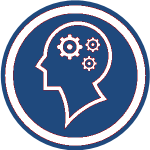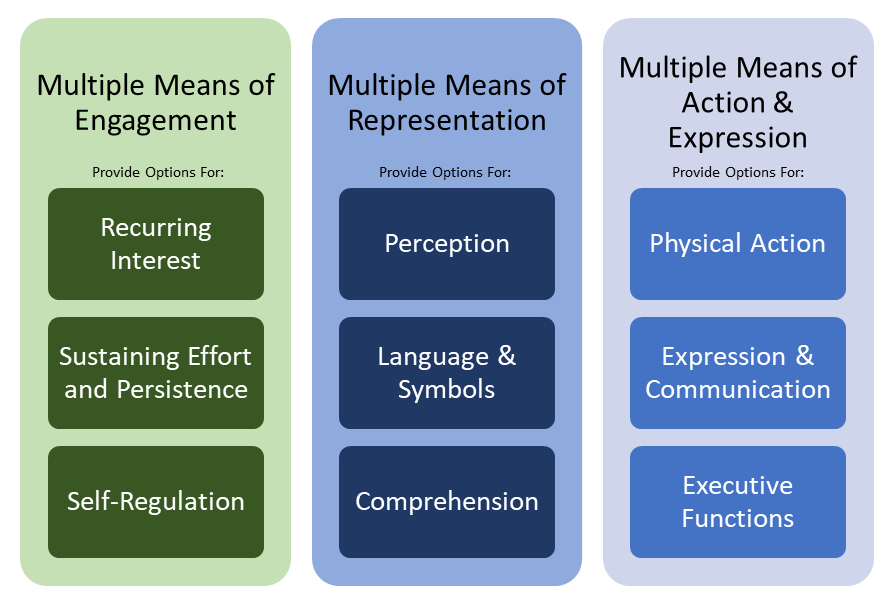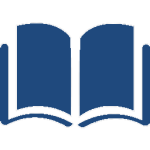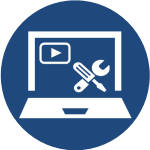10 Meaningful and Engaging
 We have already explored some of the theories and models that guide the creation of engaging online learning environments, such as the Community of Inquiry framework (Athabasca University, 2016; Garrison, Anderson & Archer, 2000) and the Fully-Online Learning Community model (Blayone et al., 2017; EILAB, 2022; Webb et al., 2019). In this chapter, we take a look at two more concepts that have guided my instructional design decisions – Universal Design for Learning (UDL) principles and the use of Problem-Based (or Project-Based) Learning (PBL) strategies.
We have already explored some of the theories and models that guide the creation of engaging online learning environments, such as the Community of Inquiry framework (Athabasca University, 2016; Garrison, Anderson & Archer, 2000) and the Fully-Online Learning Community model (Blayone et al., 2017; EILAB, 2022; Webb et al., 2019). In this chapter, we take a look at two more concepts that have guided my instructional design decisions – Universal Design for Learning (UDL) principles and the use of Problem-Based (or Project-Based) Learning (PBL) strategies.
Universal Design for Learning
CAST (2023a) has been at the forefront of developing the Universal Design for Learning framework, which it describes as “a framework to improve and optimize teaching and learning for all people based on scientific insights into how humans learn.” UDL focuses on three primary domains for designing instruction:
- Affective Networks (Engagement) – The “why” of learning.
- Recognition Networks (Representation) – The “what of learning.
- Strategic Networks (Expression) – The “how” of learning.
The guiding principles behind these domains are that learners should be provided with multiple means of engagement with learning, multiple ways of accessing the learning content, and multiple means of presenting what they have learned. These principles are summarized in the following figure:

CAST (2023b) provides a more detailed version of this figure on their UDL Guidelines page, which includes a list of the UDL outcomes associated with each domain, and links to resources to help educators and instructional designers design learning experiences that incorporate these concepts.
Using PBL Approaches
You have already seen one example of a Problem-Based (or Project-Based) Learning strategy that I have incorporated into some of my instructional design courses – the ISD project featured in this eBook. I like to use this approach because it adds meaningful context to the more abstract concepts explored in my courses and throughout this book. It also draws upon UDL principles, especially in that it promotes a contextualized understanding of the purpose of learning key ID concepts, and it provides participants with a choice in what they will create and how they will express their understanding of the concepts explored in my courses.
Another PBL Example – Open Access Publishing
 Another example of a Problem-Based (or Project-Based) Learning strategy that I have used – especially in courses that focus more heavily on learning theories and instructional design models but less on the pragmatics of building learning resources – is the co-authoring of open-access publications. In recent years, I have collaborated with course participants to publish a number of open-access eBooks related to eLearning Essentials (Power, 2020), Technology and the Curriculum (Power, 2018, 2019, 2022b), and the Integration of Instructional Design and Educational Technology (Power et al., 2020; Power, 2022a).
Another example of a Problem-Based (or Project-Based) Learning strategy that I have used – especially in courses that focus more heavily on learning theories and instructional design models but less on the pragmatics of building learning resources – is the co-authoring of open-access publications. In recent years, I have collaborated with course participants to publish a number of open-access eBooks related to eLearning Essentials (Power, 2020), Technology and the Curriculum (Power, 2018, 2019, 2022b), and the Integration of Instructional Design and Educational Technology (Power et al., 2020; Power, 2022a).
Why Open Access eBooks?
The following is taken from the introduction to one of the eBooks on which I collaborated with course participants to publish (Power, 2019):
When the idea of publishing [an open access eBook] was first conceived, [the aim was for this course] to live up to its own mandate of meaningfully integrating technology into the course curriculum, and the overall learning experience. Digital communications tools, such as the Pressbooks (2023) platform, allow for a transformation of the traditional academic paper writing experience. Rather than writing a paper to demonstrate topic understanding, and competence with writing mechanics, for just an instructor’s review, technology enables course participants to write with purpose.
This eBook chapter writing endeavour allows participants in a course… to more fully engage with their peers in the writing process, in a manner that reflects the realities of academic writing beyond the classroom. The project also allows them to share their work with a global audience. This integration of technology forces students to take deeper ownership of their work, but also allows them to share the fruits of their labours with others who could benefit from their explorations of topics related to the meaningful use of technology in education.
Admittedly, when I first conceived of the idea of drafting, peer-reviewing, editing, compiling, and publishing a professional-quality eBook in just [one term] – with a group of students who had likely never engaged in such an exercise before – I was not sure what result to expect. But, the [participants] embraced the challenge. The final product was one that everyone was excited about. We launched the publication on schedule at the end of the term. The eBook met not only with pride from the course participants, but with accolades from the Faculty of Education, and a multitude of inquiries about how to undertake similar activities from many different institutions.
The eBook Project Process
 Typically, I would integrate an open-access eBook publishing project in place of a traditional essay writing, journaling, or research paper assignment. I would break the course-long project into multiple steps, mirroring what one might encounter when responding to a publisher’s call for book chapters for a forthcoming book. These would include:
Typically, I would integrate an open-access eBook publishing project in place of a traditional essay writing, journaling, or research paper assignment. I would break the course-long project into multiple steps, mirroring what one might encounter when responding to a publisher’s call for book chapters for a forthcoming book. These would include:
- The Chapter Proposal. Participants would submit a draft Abstract (250-300 words) presenting their proposed topic, along with a proposed chapter outline and 5-6 potential resources that they could cite in their chapter. (Typically after the second to third week of the course).
- Submission of First Draft. Participants would submit a completed draft of their chapter using a provided formatting template and following APA guidelines. This draft should be anonymized to facilitate the forthcoming peer-review process. (Typically about halfway through the course.)
- Peer Reviews. Each anonymized chapter will be peer-reviewed by 2-3 classmates. I often provide a feedback template similar to the one used by many academic publishers to guide this process. I also frequently serve as one of the anonymous peer reviewers. That way, participants have no idea if the feedback they have received comes from their instructor or one of their classmates. (Typically about two-thirds of the way through the course.)
- Preparation of Final Draft. Participants must complete any revisions they deem necessary based on the feedback received from their peer reviews. They should also be prepared to describe the feedback they received, how they addressed it, and what feedback they chose not to address (with a rationale for why).
- Submission of Final Chapter. In some cases, I have asked participants to create a Pressbooks account and given them editing rights for their chapter in the eBook. They would then enter and properly format their final chapter into the platform by the course’s final week.
For some courses, I have also asked students to create a short video presentation introducing their chapter’s topic and key points. This would then be shared with the class via a dedicated discussion forum and then embedded into their chapter in the eBook to serve as a multimedia chapter introduction.
Facilitating the Peer Review Process
 There are many ways that you can facilitate the “double-blind” peer review process for this sort of book publishing activity. One of the simplest I have used is:
There are many ways that you can facilitate the “double-blind” peer review process for this sort of book publishing activity. One of the simplest I have used is:
- Have students submit anonymized copies of the chapter’s first drafts using a traditional assignment drop box in the course learning management system.
- I would then download all the drafts, assign each paper a unique ID number, and rename the files to match that number.
- I would then assign each student a unique reviewer ID number (and email them their ID numbers).
- Then, I would upload all of the chapter drafts to a Google Drive (n.d.) folder along with a list of the reviewer IDs and their assigned chapter numbers.
- I would set up another assignment drop box in the LMS, where participants must submit their completed reviews by the assignment deadline.
- Finally, I would download all of the peer review submissions from the LMS and forward copies to the appropriate chapter authors.
Another useful tool I have had the opportunity to use for a class eBook project is Kritik (Kritik Education, 2023), which automates the chapter submission, peer review, and instructor tracking processes. Of course, Kritik does have an associated licensing fee!
Activity
Course Participants
If you are a participant in one of my instructional design courses, please refer to the following for detailed instructions and appropriate templates (if applicable) for official course assignments: |
References
Anderson, T. (2003). Getting the Mix Right Again: An updated and theoretical rationale for interaction. International Review of Research in Open and Distributed Learning, 4(2). http://www.irrodl.org/index.php/irrodl/article/view/149/230
Athabasca University (n.d.). Community of Inquiry. https://coi.athabascau.ca/
Blayone, T., vanOostveen, R., Barber, W., DiGiuseppe, M., & Childs, E. (2017). Democratizing digital learning: Theorizing the Fully Online Learning Community model. International Journal of Educational Technology in Higher Education, 14(1), 13. https://doi.org/10.1186/s41239-017-0051-4
CAST (2023a). About Universal Design for Learning. https://www.cast.org/impact/universal-design-for-learning-udl
CAST (2023b). The UDL Guidelines. https://udlguidelines.cast.org/
EILAB (2022). Fully Online Learning Community (FOLC) Model. https://eilab.ca/fully-online-learning-community/
Free Icon Libary (2019). Engaging icon. [image file]. https://icon-library.com/images/engaging-icon/engaging-icon-17.jpg
Google (n.d.). Google Drive: Easy and secure access to your content. https://www.google.com/drive/
Kritik Education. (2023). Kritik: Authentic peer-to-peer interaction for a New Era of Education. https://www.kritik.io/
Power, R., Gallant, G., Gallant, J., Girouard, J., Hildebrandt, K, MacLeod, J., McCarthy, T., Mugford, J., Pinhorn, C., & Pitts, M. (2020). Integration of Instructional Design and Technology to Support Rapid Change. [eBook]. Power Learning Solutions. ISBN 978-1-9993825-3-7. https://idandrapidchange.pressbooks.com/
Power, R. (Ed). (2018). Technology and the curriculum: Summer 2018. [eBook]. Power Learning Solutions. https://techandcurriculum.pressbooks.com/
Power, R. (Ed). (2019). Technology and the curriculum: Summer 2019. [eBook]. Power Learning Solutions. ISBN 978-1-9993825-1-3. https://techandcurr2019.pressbooks.com/
Power, R. (Ed). (2020). eLearning Essentials 2020. [eBook]. Power Learning Solutions. https://elearning2020.pressbooks.com/
Power, R. (Ed.), (2022a). Integration of Instructional Design and Technology, Vol 2. [eBook]. Power Learning Solutions. ISBN 978-1-9993825-5-1. https://idandtech.pressbooks.com/
Power R. (Ed.). (2022b). Technology and the curriculum: Summer 2022. Power Learning Solutions. https://techcurr2022.pressbooks.com/
Pressbooks (2023). https://pressbooks.org/
Webb, S., van Oostveen, R., Barber, W., Percival, J. & Childs, E. (2019). Co-creation of the digital space: Examining the use of web-based tools in Fully Online Learning Community (FOLC) environments. In J. Theo Bastiaens (Ed.), Proceedings of EdMedia + Innovate Learning (pp. 1237-1242). Amsterdam, Netherlands: Association for the Advancement of Computing in Education (AACE). https://www.learntechlib.org/primary/p/210135/
 Before developing your lesson plan, unit plan, or the blueprint or storyboard for your instructional design project, consider how you could ensure that you meet all of the Universal Design for Learning principles. How could you incorporate a Problem-Based or Project-Based Learning strategy for your target students?
Before developing your lesson plan, unit plan, or the blueprint or storyboard for your instructional design project, consider how you could ensure that you meet all of the Universal Design for Learning principles. How could you incorporate a Problem-Based or Project-Based Learning strategy for your target students?